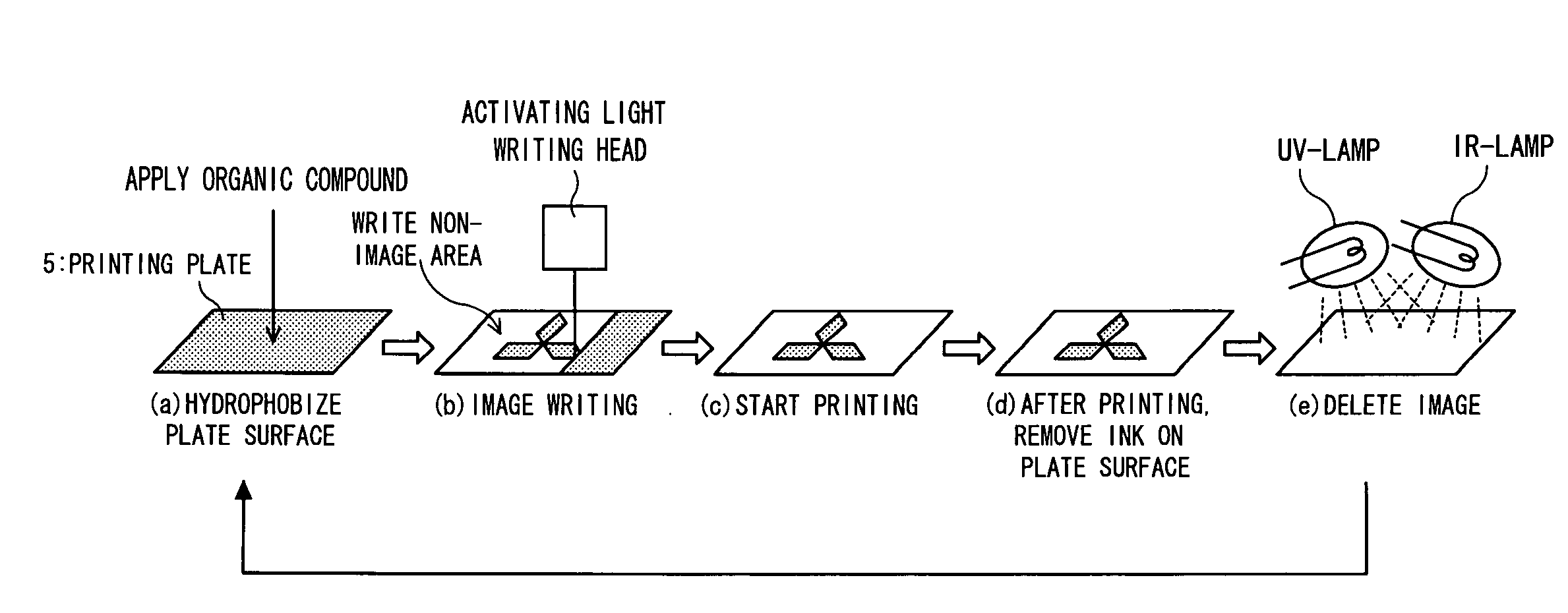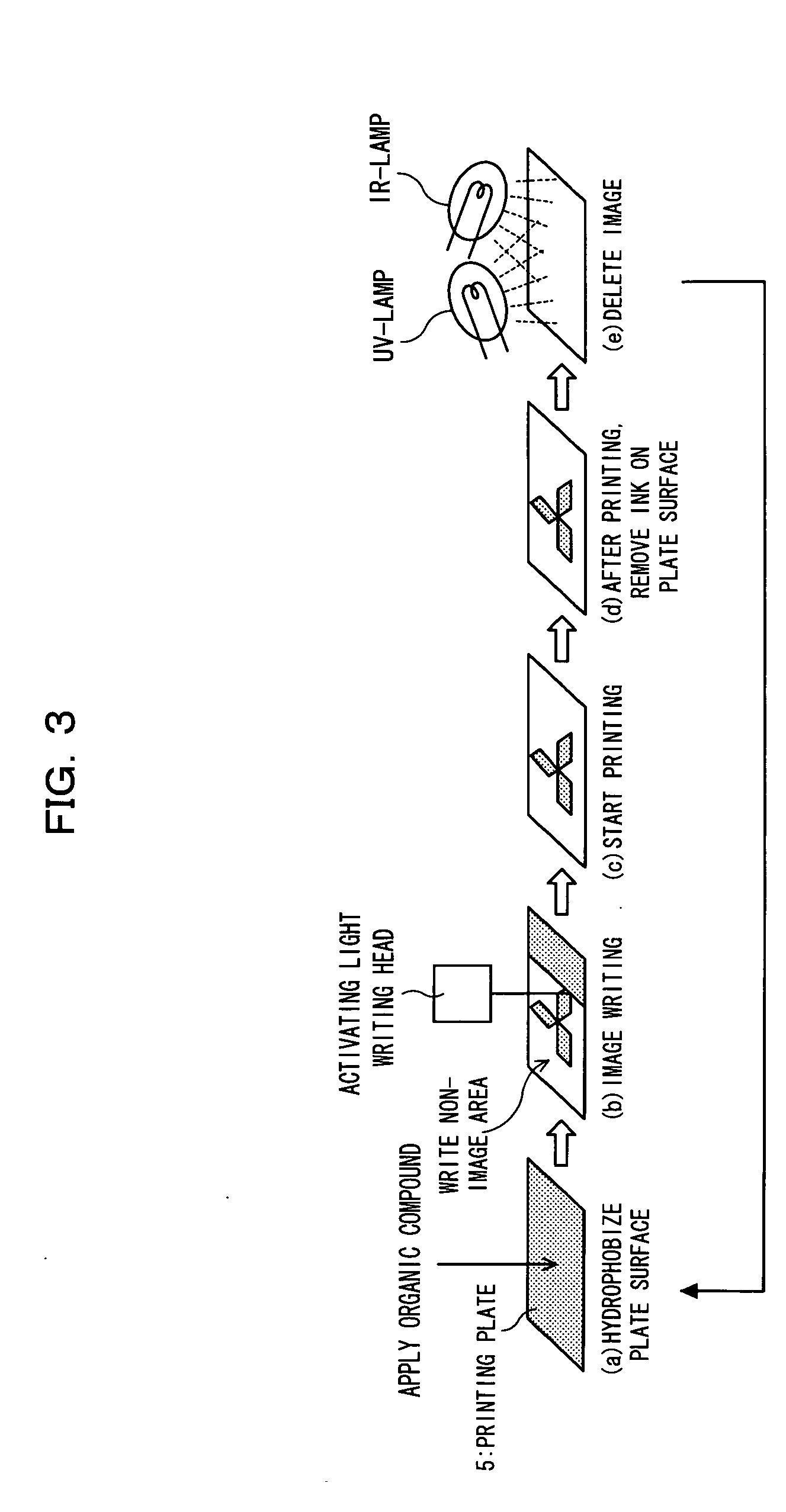Method for regenerating lithographic printing plate, regenerating device, printer, lithographic printing plate and its production method, and layered structure body and its production method
a technology of lithographic printing plate and regenerating device, which is applied in the direction of printing, foil printing, plate printing, etc., can solve the problems of increasing printing costs, difficult to promote a reduction in printing process and printing cost, and long time-consuming plate printing, etc., to promote hydrophilization, high photocatalyst activation, and rapid hydrophilization
- Summary
- Abstract
- Description
- Claims
- Application Information
AI Technical Summary
Benefits of technology
Problems solved by technology
Method used
Image
Examples
first embodiment
[1] FIRST EMBODIMENT
[0088]FIGS. 1 and 2 are diagrams showing a printing plate (layered formation) as a first embodiment of the present invention. FIG. 1 is a cross-sectional view showing a case in which the surface of the printing plate exhibits a hydrophobic nature while FIG. 2 is a cross-sectional view showing a case in which the surface of the printing plate exhibits a hydrophilic nature.
[0089] As shown in FIG. 1, a printing plate 5 is fundamentally composed of a substrate 1, an intermediate layer 2 and a photosensitive layer (photosensitive layer) 3. The printing plate may be simply referred to as a printing plate. Further, a printing plate having an image area formed on the surface thereof for printing is referred to as a plate.
[0090] The substrate 1 is composed of a metal such as aluminum, stainless steel, and polymer film or the like. However, the material therefore may not be limited to a metal such as aluminum, stainless steel, and polymer film.
[0091] The intermediate fi...
second embodiment
[2] SECOND EMBODIMENT
[0187]FIGS. 10 and 11 are diagrams each showing the printing plate (layered formation) according to a second embodiment of the present invention. FIG. 10 is a cross-sectional view showing a case in which the printing plate surface exhibits the hydrophobic nature while the FIG. 11 is a cross-sectional view showing a case in which the printing plate surface exhibits the hydrophilic nature.
[0188] As shown in FIG. 10, a printing plate 35 is fundamentally composed of the substrate 1, the intermediate layer 2, the photosensitive layer 3 and a thermoplastic resin-melt layer 34 formed by heating and melting resin fine particles. The printing plate 35 is sometimes simply referred to as a printing plate. Also, if the printing plate comes to have an image area for the printing formed on the surface thereof, this printing plate may be referred to as a plate.
[0189] The substrate 1, the intermediate layer 2 and the photosensitive layer 3 are similar to those described in th...
third embodiment
[3]THIRD EMBODIMENT
[0254] As has been described in the aforesaid background art, the inventors of the present invention studied on a theme concerning the image writing and image deleting of the printing plate (layered formation) having the photosensitive layer, and during the studies, the inventors, confirmed that if the image writing was carried out with an activating light having a luminous flux density which could provide practical level of image writing rate, there could be a chance of temperature increase on the plate surface.
[0255] Then, the inventors. of the present invention aggressively studied a technology making it possible to remarkably and simultaneously improve a photocatalyst performance, or a performance for decomposing the organic compound even under the temperature increasing condition and a performance for hydrophilizing the photocatalyst itself. As a consequence, the inventors. finally found an indispensable factor that could improve these two performances even ...
PUM
 Login to View More
Login to View More Abstract
Description
Claims
Application Information
 Login to View More
Login to View More - R&D
- Intellectual Property
- Life Sciences
- Materials
- Tech Scout
- Unparalleled Data Quality
- Higher Quality Content
- 60% Fewer Hallucinations
Browse by: Latest US Patents, China's latest patents, Technical Efficacy Thesaurus, Application Domain, Technology Topic, Popular Technical Reports.
© 2025 PatSnap. All rights reserved.Legal|Privacy policy|Modern Slavery Act Transparency Statement|Sitemap|About US| Contact US: help@patsnap.com



